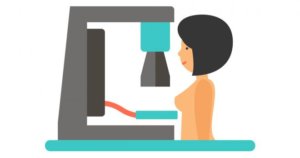- A screening mammogram is an X-ray of the breast used to detect breast changes in women who have no signs or symptoms of breast cancer. It usually involves two x-rays of each breast. With a mammogram, it is possible to detect microcalcifications (tiny deposits of calcium in the breast ) or a tumour that cannot be felt. A screening mammogram typically takes only half an hour.
- Mammograms have been used on millions of women worldwide. Like all x-rays, it involves exposure to radiation, but the amount is small even less than that used in a dentist’s x-ray. Radiation exposure from a mammogram is about 0.2 to 0.3 red per breast or roughly equivalent to less than 3 weeks of naturally occurring radiation from the environment. Simply put, the radiation exposure during a mammogram is less than that received by sitting on the beach all day in bright sunshine.
- It shouldn’t hurt but it can be uncomfortable due to the compression which is necessary for an adequate mammogram. The compression will last only a few seconds.
- Compression of the breasts is necessary to detect subtle abnormalities and reduce radiation exposure.

- Breast Compression during a mammography is necessary in order to separate overlying structures and reduce the dose of radiation.
- A high-quality mammogram with a clinical breast exam is the most effective way to detect breast cancer early. Checking one’s own breasts for lumps or other unusual changes is called breast self-exam (BSE). BSE should not take the place of clinical breast exam and mammography. Mammograms can detect breast cancer that cannot be felt.
- Cancer Institutions worldwide have laid down the following guidelines for women.
- Women should have an initial mammogram at the age of 40.
- Between the ages of 40 and 49, women should have mammograms every one or two years, depending on family and personal history.
- From the age of 50, women should have yearly mammograms.
- Regular mammography is important for ALL women. All women are at a risk for breast cancer with the risk increasing as they age. If you are a female above 50, you need a mammogram every year regardless of your family history of breast cancer.
- Unless you are experiencing symptoms, mammograms should be postponed if you are breastfeeding. It takes about 3 months for breasts to return to normal after nursing stops.
- Known risk factors for breast cancer include
- Family history of cancer.
- Late pregnancy (after 35 ) or never borne a child or late pregnancy (after 35)
- Significant radiation exposure as a child.
- Previous breast biopsies.
- A mammogram may not be a perfect assessment of your breast health. When an abnormality does appear and biopsy is recommended, only 1 out of 3 to 4 is malignant (cancerous). About 10 to 15 % of breast cancers cannot be seen on a mammogram, but mammography is still the best tool available for detecting early cancers too small to be felt.
- Since the risk of breast cancer increases with age, it is important to keep having mammograms. If cancer is found, it is best to find it early when the chance for a cure is highest. Studies have shown that a mammogram every year is the best test we have to cure breast cancer early.
- Mammograms should ideally be scheduled two or three days after a woman’s menstrual period to reduce the discomfort of breast tenderness.
- On the day of the examination, do not wear perfumes, talcum powder or deodorant in the underarm or breast
- You may find it convenient to wear a two-piece outfit because you will have to undress from the waist up and wear a gown.
Content Courtesy: Bharat Scans
